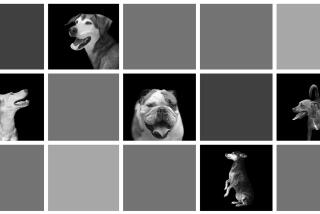Dogs Will Be Dogs, But Their Owners Need a Little Training
- Share via
Did Lassie start out this way?
At the command “Heel!” an 8-month-old Schnauzer named Toulouse began walking beside his owner, R.D. Floyd, at a comfortable pace. But soon Toulouse left Floyd’s side and stepped confidently out front, tugging slightly on the leash.
Dog trainer Jack Saltzberg was not pleased. “The dog’s leading you,” he said. “That’s a major problem.”
Toulouse and Floyd, a 41-year-old audio engineer, are members of a dog-training class taught by Saltzberg for the city of Santa Clarita’s Parks and Recreation Department. Like dogs and owners through the ages, they were experiencing a rite of passage--a tricky time that would establish who would do the most begging in the future--the dog for treats or the master for mastery.
The class, of course, is more for Homo sapiens than Canis familiaris. Dogs already know how to be dogs. But as Saltzberg said of the dog owners: “I’m training them.”
And a fine-looking class it was. Some had cobby builds, others were long-legged. Some had short hair, others had long. But all exhibited good conformation, build, color and their noses were cool.
The dogs were in fine shape too.
For the record, they were Toulouse, Barney, Sandy, Joe Cocker (a cocker spaniel, what else?), Mack, Tramp and Paddington. They sat calmly beside their owners until called upon to sit or walk or come. The owners included a statistician, an accountant and a firefighter.
If the dogs were now in the canine equivalent of high school; five weeks earlier--at their first class--they had been in Romper Room.
“When they got here, their dogs were completely-- completely-- out of control,” Saltzberg said.
The dogs fought and snarled and barked, Saltzberg recalled. Paddington, a beautiful snowy white Samoyed, ran off, leaving his 13-year-old owner, Amy Land, on the verge of tears. Some boys playing at a nearby playground helped chase him down. But on this night Paddington sat obediently at Amy’s side as Floyd tried to put Toulouse through his paces.
Toulouse has bushy eyebrows and mustache, giving him the gravely Victorian mien of the brothers pictured on boxes of cough drops. He obeyed Floyd’s commands, but did not respond well to anyone else.
“He won’t take any commands from my wife,” Floyd told Saltzberg. “He won’t take any commands from you.” Toulouse also has a strange habit if a stranger tries to walk him. “He jumps like a rabbit,” Floyd said.
Saltzberg was skeptical. A 32-year-old Los Angeles native, he learned dog training in the Israeli military a decade ago. He trained attack dogs, a vocation he abandoned when he returned to the United States, preferring to teach people how to keep peaceful pooches.
He believes any dog can be trained and, unlike most trainers, does not use a choke collar. With proper technique, discipline and love, any dog can be trained, he said.
So Saltzberg took the leash to walk Toulouse. As predicted, the schnauzer then did a pretty good impersonation of a rabbit. Saltzberg advised Floyd to practice more with the dog at home.
Saltzberg had greater control over other dogs, amazing control. He asked Bill Reed, a 29-year-old engineer, to step forward with Barney, a 2-year-old yellow Labrador retriever. After Reed instructed Barney to sit and stay, Saltzberg excitedly called to the dog. Barney jumped up to join him.
This was not good.
So Saltzberg and Reed exchanged places. Saltzberg, with authority, ordered Barney to sit and stay. Now Reed--the dog’s owner-- asked Barney to break ranks and come. But Barney wouldn’t budge. As long as Saltzberg stood beside him, the dog respected the command to sit and stay.
If the owner develops the right tone of voice and is consistent, Saltzberg explained, the dog will learn.
Now it was Paddington’s turn. Amy walked the dog a few feet and then ordered “Sit!” as she shoved hard on the dog’s rear end to make him obey.
“That was a vicious sit,” Saltzberg said. “Totally wrong.”
Commands must be firm, he said, but not harsh. He demonstrated, getting the dog to sit, stay and then come with voice and leash commands. But even an experienced trainer can forget his own strength at times.
“Yeeeeep!” the dog squealed after a particularly hard yank on his leash.
“I’m sorry,” Saltzberg told the dog. “That’s the way not to do it,” he told the class. So he apologized as best he knew how, praising the dog, rubbing him all over, making the training fun.
Saltzberg then freed the class to practice various commands for 10 minutes, walking about to monitor their progress.
The night air was filled with commands and comments--sit . . . come . . . stay . . . good . . .good boy . . . sit . . . sit . . . SIT!
Sandy, a cocker spaniel who performed well in Saltzberg’s hands, flew about like a dervish when her owner ordered her to come. Barney obeyed without enthusiasm and Joe Cocker, the best of the class, performed eagerly for owner Pat Osborne.
At the hour’s close, Saltzberg had the dogs and owners form a line, each pair about four yards apart. Each dog had to walk the length of the line, slaloming in and out among the others. The aim, of course, was to run the gauntlet without any nipping or barking.
Finally, it was Paddington’s turn. “Heel!” Land said, starting off. She was in control now, leading Paddington through the line. The dog actually seemed to be having fun.
They reached the end of the line without incident. No dog fights tonight.
“Beautiful!” Saltzberg said.
More to Read
Sign up for Essential California
The most important California stories and recommendations in your inbox every morning.
You may occasionally receive promotional content from the Los Angeles Times.













